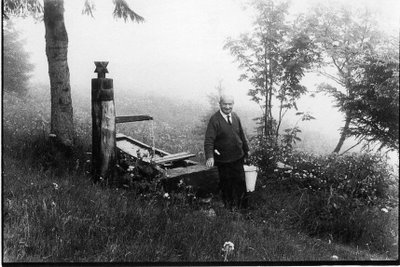 (Photo copyright Digne Meller-Marcovicz)
(Photo copyright Digne Meller-Marcovicz)Couldn’t resist posting a picture borrowed from Adam Sharr’s
Heidegger’s Hut book: the one showing Heidegger standing next to his well — the well “with the / star-die on top,” as it appears in Paul Celan’s poem “Todtnauberg”. (I first saw this photo years after I first translated the poem, and it felt strange at first, but then strangely exhilarating to see the actual object I had tried to imagine when I worked at getting “Sternwürfel” into English. As always Celan had been superbly and economically accurate in naming the seen). By coincidence, the day after the Hut-book arrived, I was teaching a class on Celan & Derrida, and had projected to use that poem as an indicator of translation difficulties (a more formal version of that discussion can be found in the essay “Translation at the Mountain of Death,” available on my
EPC site.) By a further coincidence on Tuesday, Mark Thwaite, who this week is guest-blogging on the PoetryFoundation site, posted a piece on Celan translations, which you can read
here. All of this talk about coincidences reminds of friend Eric Mottram who would arrive at my door for dinner & who, asked about how his day had been, would beam and say: “Wonderful day, imagine: not a single coincidence!” and break into his raucous laughter. But on other days & dates there are coincidences, and some of those days are great too! Below, Celan’s poem on his visit to Heidegger’s hut, in my translation:
TODTNAUBERG
Arnica, eyebright, the
draft from the well with the
star-die on top,
in the
Hütte,
written in the book
– whose name did it record
before mine – ?
in this book
the line about
a hope, today,
for a thinker’s
word
to come,
in the heart,
forest sward, unleveled,
orchis and orchis, singly,
crudeness, later, while driving,
clearly,
he who drives us, the man,
he who also hears it,
the half-
trod log-
trails on the highmoor,
humidity,
much.
(Visited 459 times, 1 visits today)


 Poasis II: Selected Poems 2000-2024
Poasis II: Selected Poems 2000-2024 “Todesguge/Deathfugue”
“Todesguge/Deathfugue” “Interglacial Narrows (Poems 1915-2021)”
“Interglacial Narrows (Poems 1915-2021)” “Always the Many, Never the One: Conversations In-between, with Florent Toniello”
“Always the Many, Never the One: Conversations In-between, with Florent Toniello” “Conversations in the Pyrenees”
“Conversations in the Pyrenees” “A Voice Full of Cities: The Collected Essays of Robert Kelly.” Edited by Pierre Joris & Peter Cockelbergh
“A Voice Full of Cities: The Collected Essays of Robert Kelly.” Edited by Pierre Joris & Peter Cockelbergh “An American Suite” (Poems) —Inpatient Press
“An American Suite” (Poems) —Inpatient Press “Arabia (not so) Deserta” : Essays on Maghrebi & Mashreqi Writing & Culture
“Arabia (not so) Deserta” : Essays on Maghrebi & Mashreqi Writing & Culture “Barzakh” (Poems 2000-2012)
“Barzakh” (Poems 2000-2012) “Fox-trails, -tales & -trots”
“Fox-trails, -tales & -trots” “The Agony of I.B.” — A play. Editions PHI & TNL 2016
“The Agony of I.B.” — A play. Editions PHI & TNL 2016 “The Book of U / Le livre des cormorans”
“The Book of U / Le livre des cormorans” “Memory Rose Into Threshold Speech: The Collected Earlier Poetry of Paul Celan”
“Memory Rose Into Threshold Speech: The Collected Earlier Poetry of Paul Celan” “Paul Celan, Microliths They Are, Little Stones”
“Paul Celan, Microliths They Are, Little Stones” “Paul Celan: Breathturn into Timestead-The Collected Later Poetry.” Translated & with commentary by Pierre Joris. Farrar, Straus & Giroux
“Paul Celan: Breathturn into Timestead-The Collected Later Poetry.” Translated & with commentary by Pierre Joris. Farrar, Straus & Giroux
“Im Verlauf meiner weiteren Beschäftigung mit den Skizzenbüchern und dem Leben Turners bin ich dann auf die an sich völlig bedeutungslose, mich aber nichtsdestoweniger eigenartig berührende Tatsache gestoßen, dass er, Turner, im Jahr 1798, auf einer Landfahrt durch Wales, auch an der Mündung des Mawddach gewesen ist und dass er zu jener Zeit genauso alt war wie ich bei dem Begräbnis von Cutiau.” (Sebald, Austerlitz)
bedeutungslos … aber berührend: one of the most beautiful comments about coincidence that I have ever come across.